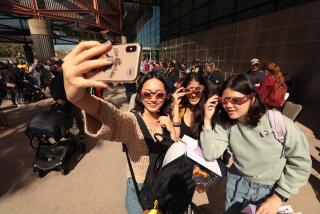Lowell Observatory: Can crowdsourcing fix iconic telescope?
- Share via
Is it possible to crowdsource an old telescope? The Lowell Observatory in Flagstaff, Ariz., is about to find out.
Built by the astronomer Percival Lowell in 1894, the 24-inch Alvan Clark Telescope has been in continuous use for 117 years. About the turn of the 20th century, Lowell used it to study Mars — famously arguing (incorrectly) that “canals” he saw on the planet’s surface were evidence of intelligent life. Astronomer V.M. Slipher discovered galactic redshifts there in 1912; the Apollo program used the instrument to prepare for moon missions.
For some time now, the telescope, which is near downtown Flagstaff and is a National Historic Landmark, has been used mainly for public outreach and education. (The Los Angeles Times wrote this piece about the telescope on its 100th anniversary in 1994; information on visiting it is available here.) On almost any clear night, stargazers line up at the Clark Telescope to peer into the heavens — more than a million over the last 20 years, according to observatory outreach manager Kevin Schindler.
But that kind of traffic brings a lot of wear and tear, he said. It’s gotten hard for telescope staff to open the shutter doors on the dome, which have “been banged up over the years.” In the winter, snow drifts in from holes in the ceiling. Sometimes, workers have to climb on ladders to aim the telescope properly toward the sky, causing delays for visitors. The facility’s century-old electrical system casts off sparks and arcs.
“We have a dome of Ponderosa pine,” Schindler said. “We don’t like sparking and arcing.”
Hoping to stave off further damage and prevent a bigger overhaul down the road, the nonprofit observatory has begun a 60-day campaign on the fundraising website Indiegogo to bring in about a quarter of a million dollars for repairs.
Chuck Wendt, deputy director of advancement for the observatory, admitted that was a lot of money and joked that he had a “backup plan” that involved hitting the streets of Flagstaff with a sandwich board and a tin cup. But he also said he was “cautiously optimistic” the observatory’s campaign would pay off. Six days in, the Clark had racked up more than $12,000 in donations from 160 people. At a launch event for the effort, Wendt said, staffers were glued to their smartphones, nervously tracking the donations as they trickled in.
If the push is ultimately successful, the observatory, which is funded by Percival Lowell’s estate, will look at crowdsourcing to help pay for other needs, Wendt said — perhaps even turning to the masses to support the scientific work pursued by its 24 astronomers. (Traditionally, they have depended on grants from the National Science Foundation and NASA.) Earlier this year, the observatory unveiled the 4.28-meter Discovery Channel Telescope, paid for in part by the cable science channel. Wendt said the channel did not tell scientists at the observatory what to do, but did plan to make television shows about the research that goes on there.
“With the federal government tightening resources, it’s possible some of the money scientists have been used to getting won’t be there,” he said. “Hopefully it won’t happen, but maybe we can keep scientists working by paying their expenses. We’re looking at a lot of funding sources.”
Follow me on Twitter: @LATerynbrown







